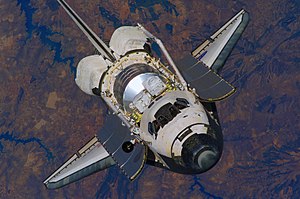
Back مركبة مكوك الفضاء المدارية Arabic Orbitador del transbordador espacial Catalan Družicový stupeň raketoplánu Czech Gwennol y Gofod CY Orbitador del transbordador espacial Spanish Kosmosesüstik (Space Shuttle) ET مدارگرد شاتل فضایی FA Navette spatiale French Space Shuttle Orbiter Hungarian Pengorbit Pesawat Ulang Alik ID
 | |
| Manufacturer | Rockwell International (North American Aircraft Operations) |
|---|---|
| Country of origin | United States |
| Operator | NASA |
| Applications | Crew and cargo spaceplane |
| Specifications | |
| Spacecraft type | Crewed, reusable |
| Launch mass | 110,000 kg (240,000 lb) |
| Dry mass | 78,000 kg (172,000 lb) |
| Regime | Low Earth orbit |
| Dimensions | |
| Length | 37.237 m (122.17 ft) |
| Height | 17.86 m (58.6 ft) |
| Wingspan | 23.79 m (78.1 ft) |
| Capacity | |
| Payload to Low Earth orbit | |
| Mass | 24,310 kg (53,590 lb) |
| Production | |
| Status | Retired |
| Built | 6 |
| Launched | 5 orbiters 135 missions |
| Lost | 2 orbiters |
| Maiden launch | Space Shuttle Columbia STS-1 (April 12, 1981) |
| Last launch | Space Shuttle Atlantis STS-135 (July 8, 2011) |
| Last retirement | Space Shuttle Atlantis STS-135 (July 21, 2011) |
The Space Shuttle orbiter is the spaceplane component of the Space Shuttle, a partially reusable orbital spacecraft system that was part of the discontinued Space Shuttle program. Operated from 1977 to 2011 by NASA,[1] the U.S. space agency, this vehicle could carry astronauts and payloads into low Earth orbit, perform in-space operations, then re-enter the atmosphere and land as a glider, returning its crew and any on-board payload to the Earth.
Six orbiters were built for flight: Enterprise, Columbia, Challenger, Discovery, Atlantis, and Endeavour. All were built in Palmdale, California, by the Pittsburgh, Pennsylvania-based Rockwell International company's North American Aircraft Operations branch. The first orbiter, Enterprise, made its maiden flight in 1977. An unpowered glider, it was carried by a modified Boeing 747 airliner called the Shuttle Carrier Aircraft and released for a series of atmospheric test flights and landings. Enterprise was partially disassembled and retired after completion of critical testing. The remaining orbiters were fully operational spacecraft, and were launched vertically as part of the Space Shuttle stack.
Columbia was the first space-worthy orbiter; it made its inaugural flight in 1981. Challenger, Discovery, and Atlantis followed in 1983, 1984, and 1985 respectively. In 1986, Challenger was destroyed in a disaster shortly after its 10th launch, killing all seven crew members. Endeavour was built as Challenger's successor, and was first launched in 1992. In 2003, Columbia was destroyed during re-entry, leaving just three remaining orbiters. Discovery completed its final flight on March 9, 2011, and Endeavour completed its final flight on June 1, 2011. Atlantis completed the final Shuttle flight, STS-135, on July 21, 2011.
In addition to their crews and payloads, the reusable orbiter carried most of the Space Shuttle System's liquid-propellant rocket system, but both the liquid hydrogen fuel and the liquid oxygen oxidizer for its three main rocket engines were fed from an external cryogenic propellant tank. Additionally, two reusable solid rocket boosters (SRBs) provided additional thrust for approximately the first two minutes of launch. The orbiters themselves did carry hypergolic propellants for their Reaction Control System (RCS) thrusters and Orbital Maneuvering System (OMS) engines.